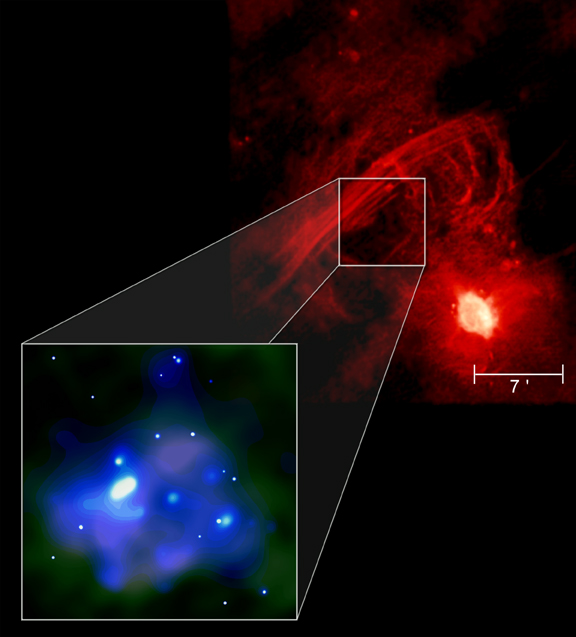Galactic center radio arc, Sagittarius A* (APOD 27 Apr 2008)
Galactic center radio arc, Sagittarius A* (APOD 27 Apr 2008)
Can someone please give an indication about the size covered by today, April 27 2008's picture both in terms of angular measurement and, while we're at it, distance and estimated real size ?
Generally I'd appreciate if the angular size of the area shown was alwas given with APOD ! I think I emailed Robert Nemiroff with a similar request, years ago, so let this be a gentle & humble reminder.
Generally I'd appreciate if the angular size of the area shown was alwas given with APOD ! I think I emailed Robert Nemiroff with a similar request, years ago, so let this be a gentle & humble reminder.
Czerno
Re: Galactic center - radio arc, APOD 2008-04-27
G'day,Czerno wrote:Can someone please give an indication about the size covered by today, April 27 2008's picture both in terms of angular measurement and, while we're at it, distance and estimated real size ?
When you click on "the above radio image" in the legend of todays APOD, and click further to image number 5, i.e.

you will see that todays APOD is slightly smaller than the size of the moon. I estimate it as 20-25 arc minutes. In a rather detailed article by Lazenby, Lazenby and Yusef-Zadeh the distance to the galactic center has been fixed at 8.5 kpc, so the size of the arc is about 100pc. (1pc ≅ 3.26 ly).
I do not know how an APOD is chosen and delivered to the webmaster. I guess a webmaster can not impose demands to people that voluntary provide us with images: "Now add a scale to the image!". The only sanction would be: not to publish the image, which is not in the interest of APOD visitors. Nonetheless i second your request for "adding scales to images".Czerno wrote:Generally I'd appreciate if the angular size of the area shown was alwas given with APOD ! I think I emailed Robert Nemiroff with a similar request, years ago, so let this be a gentle & humble reminder.
I was puzzled by what "optical depth" is. I found an answer at:
http://en.wikipedia.org/wiki/Optical_depth
Optical depth is the key to understand the Lazenby et al. article.
What is nice to see is that the good old 21 cm H1 line has been used to determine the geometry of the arc and relate it to the Sgr A source.
Regards
Regards,
Henk
21 cm: the universal wavelength of hydrogen
Henk
21 cm: the universal wavelength of hydrogen
Sagittarius A*
The putative supermassive black hole at the center of our Milky Way is much too low in mass to exert gravitational influence on stars outside its nearby vicinity. So, if the Milky Way (and other spiral galaxies) are not whirling around a central black hole, then what are they whirling around? Why are some galaxies spiral and others elliptical? Do stars in elliptical galaxies have regular orbits around a central point? Thank you.
The center of our galaxy is shrouded in dark clouds. There aren't any stars visible. The center of the APOD is at α = 17h 43 minutes and δ = -28° 55' (1950.0). See the article by Lazenby et al., page 179 :BMAONE23 wrote:Can anyone take the Radio Arc image and superimpose it over a visual light image of the galactic center and properly orient it against the stars?
http://articles.adsabs.harvard.edu//ful ... 9.000.html
The closest visible star (to the naked eye) is χ Sag, roughly one degree to the North.
Regards,
Henk
21 cm: the universal wavelength of hydrogen
Henk
21 cm: the universal wavelength of hydrogen
- iamlucky13
- Commander
- Posts: 515
- Joined: Thu May 25, 2006 7:28 pm
- Location: Seattle, WA
Re: Sagittarius A*
Well first of all, the black hole in Saggitarius-A is estimated to be 2-3 million solar masses, so it's not tiny. But you are correct that it exerts a minimal influence outside of the local area compared to the estimated 500 billion solar mass total mass of the Milky Way.Javachip wrote:The putative supermassive black hole at the center of our Milky Way is much too low in mass to exert gravitational influence on stars outside its nearby vicinity. So, if the Milky Way (and other spiral galaxies) are not whirling around a central black hole, then what are they whirling around? Why are some galaxies spiral and others elliptical? Do stars in elliptical galaxies have regular orbits around a central point? Thank you.
The key is that the stars all orbit the common gravitational center of the Milky Way. If you take any given star and sum up all the gravitational influences on it from all the other stars and clouds of gas and dust in the galaxy (and dark matter), it averages out to be focused on the center of the galaxy.
An elliptical galaxy just means it's deformed into an elliptical shape. I believe this is typically because the orbits are more eccentric, but it's also possible that outside influences like a close pass by another galaxy can stretch a galaxy into an ellipse.
"Any man whose errors take ten years to correct is quite a man." ~J. Robert Oppenheimer (speaking about Albert Einstein)
Re: Sagittarius A*
I am not sure about that. I think that an elliptical galaxy was formed by successive mergers of spiral and irregular galaxies. Most elliptical galaxies are composed of older, low-mass stars, with a sparse interstellar medium and minimal star formation activity.iamlucky13 wrote: An elliptical galaxy just means it's deformed into an elliptical shape. I believe this is typically because the orbits are more eccentric, but it's also possible that outside influences like a close pass by another galaxy can stretch a galaxy into an ellipse.
Fight ignorance!